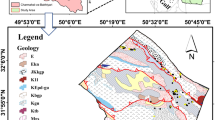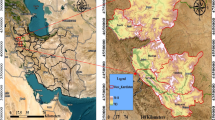Abstract
Earth fissures in Su-Xi-Chang land subsidence area have induced massive damages to the area. The non-linear characteristic associated with the process of earth fissure formation requires non-linear method for evaluating the occurrence of the hazard. Based on quantification of influence factors on breeding the hazard, GA-ANN method, which integrates artificial neural networks (ANN) with genetic algorithms (GA), is developed for evaluating the occurrence of earth fissure hazard. Six indicators, that include the depth of bedrock burial (DBB), the degree of bedrock relief (DBR), water level (WL) (the II confined aquifer), the gradient of land subsidence (GLS), transmissivity (T) (the II confined aquifer) and the thickness of clay soil (TCS), are selected as the input patterns of the integrated approach, and danger index (DI) as the output pattern. A multilayer back-propagation neural network is trained with 30 sets of data samples including 15 sets of earth fissure samples and 15 sets of safety samples for defining the architecture of ANN. Subsequently, GA is employed by optimizing the initial weights of trained ANN by minimizing the deviation of output. The efficacy of the integrated approach is demonstrated by comparing the deviation of output from ANN and GA-ANN for 5 testing samples and the result shows that the GA-ANN method is more accurate than ANN in identifying the occurrence of earth fissure. The integrated method is applied to the assessment of earth fissure hazard in typical regions of earth fissure. According to the classification of DI, the regions are divided into four zones — danger zone, sub-danger zone, sub-safe zone and safe zone.
Similar content being viewed by others
References
Ayalew, L., Yamagishi, H., and Reik, G., 2004, Ground cracks in Ethiopian Rift Valley: facts and uncertainties. Engineering Geology, 75, 309–324.
Bernhard, S. and Martin, K., 1999, A model for the dynamic interaction between evolution and learning. Neural Processing Letters, 10, 181–193.
Bievre, G., Jongmans, D., and Winiarski, T., 2012, Application of geophysical measurements for assessing the role of fissures in water infiltration within a clay landslide (Trieves area, French Alps). Hydrological Processes, 14, 2128–2142.
Chen, C.R. and Ramaswamy, H.S., 2002, Modeling and optimization of variable retort temperature (VRT) thermal processing using coupled neural networks and genetic algorithms. Journal of Food Engineering, 53, 209–220.
Chen, C.X., Pei, S.P., and Jiao, J.J., 2003, Land subsidence caused by groundwater exploitation in Suzhou city, China. Hydrogeology Journal, 11, 275–287.
Cook, D.F., Ragsdale, C.T., and Major, R.L., 2000, Combining a neural network with a genetic algorithm for process parameter optimization. Engineering Applications of Artificial Intelligence, 13, 391–396.
Dong, W.H., Kang, B., Du, S.H., and Shi, X.F., 2013, Estimation of shallow groundwater ages and circulation rates in the Henan Plain, China: CFC and deuterium excess methods. Geosciences Journal, 17, 479–488.
Du, S.H., Su, X.S., and Zhang, W.J., 2013, Effective storage rates analysis of groundwater reservoir with surplus local and transferred water used in Shijiazhuang City, China, Water and Environment Journal, 27, 157–169.
Galloway, D.L. and Burbey, T.J., 2011, Review: regional land subsidence accompanying groundwater extraction. Hydrogeology Journal, 19, 1459–1486.
Hu, C.H., Hao, Y.H., Yeh, T.C., Pang, B., and Wu, Z.M., 2008, Simulation of spring flows from a karst aquifer with an artificial neural network. Hydrological Processes, 22, 596–604.
Li, Y., Yang, J., and Hu, X., 2000, Origin of ground fissures in the Shanxi Graben system, Northern China. Engineering Geology, 55, 267–275.
Su, X.S., Xu, W., and Du, S.H., 2014a, Responses of groundwater vulnerability to artificial recharge under extreme weather conditions in Shijiazhuang City, China. Journal of Water Supply: Research and Technology-Aqua, 63, 224–238, DOI: 10.2166/aqua.2013.132.
Su, X.S., Xu, W., and Du, S.H., 2014b, In situ infiltration test using a reclaimed abandoned river bed: managed aquifer recharge in Shijiazhuang City, China. Environmental Earth Sciences, 71, 5017–5025, DOI: 10.1007/s12665-013-2893-y.
Wang, J.M. and Xie, G.L., 2000, Theory of ground fissures hazards and its application. Shaanxi Science and Technology Press, Xi’an, 574 p.
Wang, G.Y., You, G.G., and Shi, B., 2010, Large differential land subsidence and earth fissures in Jiangyin, China. Environmental Earth Sciences, 61, 1085–1093.
Wu, Q., Ye, S.Y., Wu, Q., and Chen, P.P., 2003, A nonlinear modeling and forecasting system of earth fractures based on coupling of artificial neural network and geographical information system-exemplified by earth fractures in Yuci City, Shanxi, China. Environmental Geology, 45, 124–131.
Wu, Q., Ye, S.Y., Wu, Q., and Chen, P.P., 2004, Risk assessment of earth fractures by constructing an intrinsic vulnerability map, specific vulnerability map, and a hazard map, using Yuci City, Shanxi, China as an example. Environmental Geology, 46, 104–112.
Xu, Y.S., Shen, S.L., and Cai, Z.Y., 2008, The state of land subsidence and prediction approaches due to groundwater withdrawal in China. Natural Hazards, 45, 123–135.
Xue, Y.Q., Zhang, Y., and Ye, S.J., 2005, Land subsidence in China. Environmental Geology, 48, 713–720.
Yutaka, F., Hideo, M., and Haruyuki, M., 1998, A modified backpropagation method to avoid false local minima. Neural Network, 11, 1059–1072.
Zhang, Y., Xue, Y.Q., and Wu, J.C., 2008, Land subsidence and earth fissures due to groundwater withdrawal in the southern Yangtse Delta, China. Environmental Geology, 55, 751–762.
Author information
Authors and Affiliations
Corresponding author
Rights and permissions
About this article
Cite this article
Zhang, W., Gao, L., Jiao, X. et al. Occurrence assessment of earth fissure based on genetic algorithms and artificial neural networks in Su-Xi-Chang land subsidence area, China. Geosci J 18, 485–493 (2014). https://doi.org/10.1007/s12303-014-0020-z
Received:
Accepted:
Published:
Issue Date:
DOI: https://doi.org/10.1007/s12303-014-0020-z




